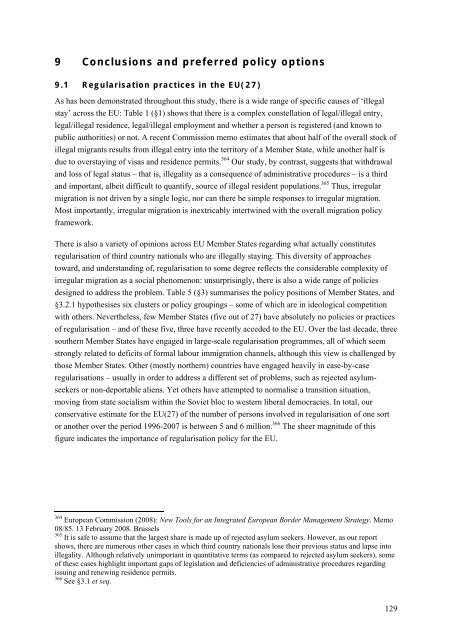REGINE Regularisations in Europe Final Report - European ...
REGINE Regularisations in Europe Final Report - European ...
REGINE Regularisations in Europe Final Report - European ...
You also want an ePaper? Increase the reach of your titles
YUMPU automatically turns print PDFs into web optimized ePapers that Google loves.
9 Conclusions and preferred policy options<br />
9.1 Regularisation practices <strong>in</strong> the EU(27)<br />
As has been demonstrated throughout this study, there is a wide range of specific causes of ‘illegal<br />
stay’ across the EU: Table 1 (§1) shows that there is a complex constellation of legal/illegal entry,<br />
legal/illegal residence, legal/illegal employment and whether a person is registered (and known to<br />
public authorities) or not. A recent Commission memo estimates that about half of the overall stock of<br />
illegal migrants results from illegal entry <strong>in</strong>to the territory of a Member State, while another half is<br />
due to overstay<strong>in</strong>g of visas and residence permits. 364 Our study, by contrast, suggests that withdrawal<br />
and loss of legal status – that is, illegality as a consequence of adm<strong>in</strong>istrative procedures – is a third<br />
and important, albeit difficult to quantify, source of illegal resident populations. 365 Thus, irregular<br />
migration is not driven by a s<strong>in</strong>gle logic, nor can there be simple responses to irregular migration.<br />
Most importantly, irregular migration is <strong>in</strong>extricably <strong>in</strong>tertw<strong>in</strong>ed with the overall migration policy<br />
framework.<br />
There is also a variety of op<strong>in</strong>ions across EU Member States regard<strong>in</strong>g what actually constitutes<br />
regularisation of third country nationals who are illegally stay<strong>in</strong>g. This diversity of approaches<br />
toward, and understand<strong>in</strong>g of, regularisation to some degree reflects the considerable complexity of<br />
irregular migration as a social phenomenon: unsurpris<strong>in</strong>gly, there is also a wide range of policies<br />
designed to address the problem. Table 5 (§3) summarises the policy positions of Member States, and<br />
§3.2.1 hypothesises six clusters or policy group<strong>in</strong>gs – some of which are <strong>in</strong> ideological competition<br />
with others. Nevertheless, few Member States (five out of 27) have absolutely no policies or practices<br />
of regularisation – and of these five, three have recently acceded to the EU. Over the last decade, three<br />
southern Member States have engaged <strong>in</strong> large-scale regularisation programmes, all of which seem<br />
strongly related to deficits of formal labour immigration channels, although this view is challenged by<br />
those Member States. Other (mostly northern) countries have engaged heavily <strong>in</strong> case-by-case<br />
regularisations – usually <strong>in</strong> order to address a different set of problems, such as rejected asylumseekers<br />
or non-deportable aliens. Yet others have attempted to normalise a transition situation,<br />
mov<strong>in</strong>g from state socialism with<strong>in</strong> the Soviet bloc to western liberal democracies. In total, our<br />
conservative estimate for the EU(27) of the number of persons <strong>in</strong>volved <strong>in</strong> regularisation of one sort<br />
or another over the period 1996-2007 is between 5 and 6 million. 366 The sheer magnitude of this<br />
figure <strong>in</strong>dicates the importance of regularisation policy for the EU.<br />
364 <strong>Europe</strong>an Commission (2008): New Tools for an Integrated <strong>Europe</strong>an Border Management Strategy. Memo<br />
08/85. 13 February 2008. Brussels<br />
365 It is safe to assume that the largest share is made up of rejected asylum seekers. However, as our report<br />
shows, there are numerous other cases <strong>in</strong> which third country nationals lose their previous status and lapse <strong>in</strong>to<br />
illegality. Although relatively unimportant <strong>in</strong> quantitative terms (as compared to rejected asylum seekers), some<br />
of these cases highlight important gaps of legislation and deficiencies of adm<strong>in</strong>istrative procedures regard<strong>in</strong>g<br />
issu<strong>in</strong>g and renew<strong>in</strong>g residence permits.<br />
366 See §3.1 et seq.<br />
129
















